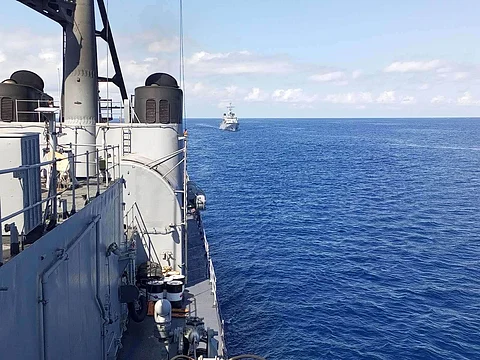
- NEWS
- the EDIT
- COMMENTARY
- BUSINESS
- LIFE
- SHOW
- ACTION
- GLOBAL GOALS
- SNAPS
- DYARYO TIRADA
- MORE

The ongoing Balikatan (shoulder-to-shoulder) Exercise would be the “perfect training ground” for the Philippines’ Comprehensive Archipelagic Defense Concept (CADC) — the country’s new defense paradigm, in view of the heightened tensions in the West Philippine Sea (WPS).
Lt. Gen. Michael Cederholm, commanding general of the United States 1 Marine Expeditionary Force, said Balikatan’s combat drills, which will focus on integrated air missile defense, cyber defense, and other relevant exercises, can contribute to the country’s deterrent efforts against external security threats.
“This is the perfect training ground,” he said.
Defense Secretary Gilberto Teodoro Jr. said the CADC aims to develop the country’s capability to protect its entire territory, including its exclusive economic zone (EEZ), to ensure that the next generation of Filipinos will be able to enjoy its natural resources.
The CADC, he added, will allow the AFP to protect and guarantee “Philippine nationals, Philippine corporations, and those authorized by the Philippine government the unimpeded and peaceful exploration and exploitation of all natural resources within our EEZ and other areas over which we have jurisdiction.”
The CADC was introduced after the China Coast Guard increased its dangerous maneuvers against Philippine vessels at Ayungin Shoal.
Most significant element
The United States has once again reiterated its support to the Philippines, even in the event of external aggression, “in honor of the existing Mutual Defense Treaty.”
“The Mutual Defense Treaty (MDT) was there for more than 70 years and we take that very seriously and my President (Joe Biden) recently said that we will honor those treaties and abrogations,” Cederholm told reporters in a press conference at the start of the military exercise.
The MDT has been the most significant element of the Philippine-US alliance since 1951.
“With the Philippines and the United States, I think we have a shared vision in an open and free Indo-Pacific region,” Cederholm said.
He said this shared vision can be characterized by “transparency, rules of international order, respect of sovereignty and seeking a peaceful resolution of the conflict.”
“I think that’s the opportunity that the United States looks to join into, we’ve done this for 39 years,” he pointed out, when asked if the US sees going beyond joint trainings with the Philippines.
“It’s an ironclad alliance, which we take seriously and we honor and we look forward to training in the opportunity to come, in that integration, both on the ground and in communities,” Cederholm stressed.
Naval forces are sailing
The Armed Forces of the Philippines on Thursday confirmed that naval vessels of the Philippines, the United States, and France have started sailing within the country’s exclusive economic zone in the West Philippine Sea.
Capt. Ariel Coloma, AFP Western Command spokesperson, said the group sail is part of the Mutual Maritime Exercise (MME) under this year’s execution of the Philippines-US Balikatan war games.
“As we speak, our ships are setting sail from Puerto Princesa. They have lined up training activities. In fact, upon reaching the eastern coast of Palawan, they will begin holding division tactics, officer of watch maneuvers,” he said.
The Philippine Navy’s BRP Davao del Sur and BRP Ramon Alcaraz with the French Navy’s Floreal-class frigate FS Vendemiaire and America’s USS Harpers Ferry departed Puerto Princesa, Palawan on Thursday morning and are expected to sail in the WPS until Monday, 29 April.
Coloma said the three countries’ ships will sail together from the east coast to the north of Mindoro Strait and enter the WPS.
“So the exercise will continue, including the photo exercise and then the gunnery exercise, that will be until April 29,” he added.
Further, the Davao del Sur will demonstrate an amphibious assault on 30 April.
Coloma emphasized that the MME also aims to enhance the maritime interoperability of the Philippines with its allied countries.
He said the exercise will also test the participants’ new equipment, techniques, tactics, and procedures for defense.
Chinese presence expected
Coloma said the group sea drills during the MME will continue with or without China’s presence in the WPS.
“We monitor them and we record their presence in our area — within our exclusive economic zone — but in terms of the Balikatan exercise, we will push through with our events, we will push through with the serials lined up for our ships and our units,” he stressed.
Coloma said the Balikatan drills had been carefully planned a long time ago, thus they don’t see any reason to discontinue the slated events due to China’s presence.
Philippine Navy spokesperson for WPS, Commodore Roy Vincent Trinidad, noted the surge in Chinese maritime militia (CMM) vessels in the WPS as the Philippines and United States formally opened their annual bilateral Balikatan Exercise earlier this week.
